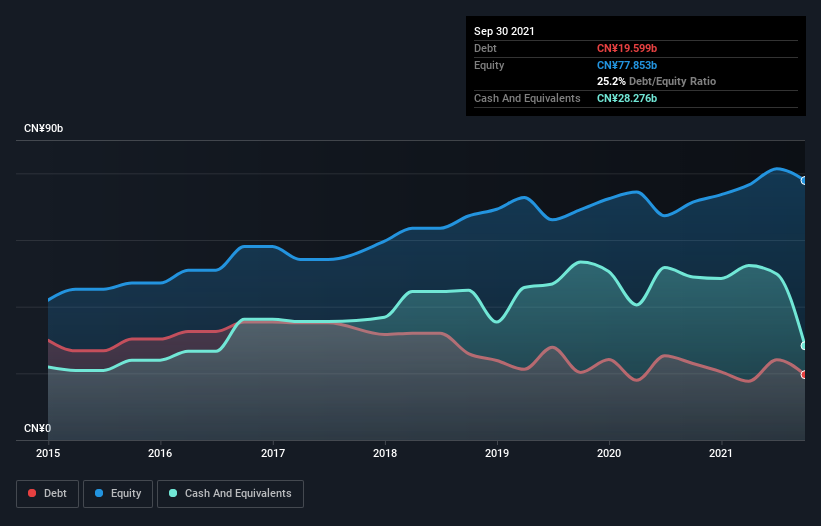Warren Buffett famously said, 'Volatility is far from synonymous with risk.' So it might be obvious that you need to consider debt, when you think about how risky any given stock is, because too much debt can sink a company. Importantly, BAIC Motor Corporation Limited (HKG:1958) does carry debt. But should shareholders be worried about its use of debt?
What Risk Does Debt Bring?
Generally speaking, debt only becomes a real problem when a company can't easily pay it off, either by raising capital or with its own cash flow. Ultimately, if the company can't fulfill its legal obligations to repay debt, shareholders could walk away with nothing. However, a more frequent (but still costly) occurrence is where a company must issue shares at bargain-basement prices, permanently diluting shareholders, just to shore up its balance sheet. Of course, debt can be an important tool in businesses, particularly capital heavy businesses. The first thing to do when considering how much debt a business uses is to look at its cash and debt together.
View our latest analysis for BAIC Motor
What Is BAIC Motor's Debt?
The image below, which you can click on for greater detail, shows that BAIC Motor had debt of CN¥19.6b at the end of September 2021, a reduction from CN¥23.0b over a year. However, its balance sheet shows it holds CN¥28.3b in cash, so it actually has CN¥8.68b net cash.

A Look At BAIC Motor's Liabilities
We can see from the most recent balance sheet that BAIC Motor had liabilities of CN¥81.8b falling due within a year, and liabilities of CN¥15.2b due beyond that. On the other hand, it had cash of CN¥28.3b and CN¥17.2b worth of receivables due within a year. So it has liabilities totalling CN¥51.5b more than its cash and near-term receivables, combined.
This deficit casts a shadow over the CN¥21.4b company, like a colossus towering over mere mortals. So we definitely think shareholders need to watch this one closely. After all, BAIC Motor would likely require a major re-capitalisation if it had to pay its creditors today. Given that BAIC Motor has more cash than debt, we're pretty confident it can handle its debt, despite the fact that it has a lot of liabilities in total.
The good news is that BAIC Motor has increased its EBIT by 5.0% over twelve months, which should ease any concerns about debt repayment. When analysing debt levels, the balance sheet is the obvious place to start. But it is future earnings, more than anything, that will determine BAIC Motor's ability to maintain a healthy balance sheet going forward. So if you're focused on the future you can check out this free report showing analyst profit forecasts.
But our final consideration is also important, because a company cannot pay debt with paper profits; it needs cold hard cash. While BAIC Motor has net cash on its balance sheet, it's still worth taking a look at its ability to convert earnings before interest and tax (EBIT) to free cash flow, to help us understand how quickly it is building (or eroding) that cash balance. Looking at the most recent three years, BAIC Motor recorded free cash flow of 33% of its EBIT, which is weaker than we'd expect. That weak cash conversion makes it more difficult to handle indebtedness.
Summing up
Although BAIC Motor's balance sheet isn't particularly strong, due to the total liabilities, it is clearly positive to see that it has net cash of CN¥8.68b. And it also grew its EBIT by 5.0% over the last year. Despite its cash we think that BAIC Motor seems to struggle to handle its total liabilities, so we are wary of the stock. There's no doubt that we learn most about debt from the balance sheet. However, not all investment risk resides within the balance sheet - far from it. For example BAIC Motor has 2 warning signs (and 1 which is significant) we think you should know about.
If you're interested in investing in businesses that can grow profits without the burden of debt, then check out this free list of growing businesses that have net cash on the balance sheet.
Valuation is complex, but we're here to simplify it.
Discover if BAIC Motor might be undervalued or overvalued with our detailed analysis, featuring fair value estimates, potential risks, dividends, insider trades, and its financial condition.
Access Free AnalysisThis article by Simply Wall St is general in nature. We provide commentary based on historical data and analyst forecasts only using an unbiased methodology and our articles are not intended to be financial advice. It does not constitute a recommendation to buy or sell any stock, and does not take account of your objectives, or your financial situation. We aim to bring you long-term focused analysis driven by fundamental data. Note that our analysis may not factor in the latest price-sensitive company announcements or qualitative material. Simply Wall St has no position in any stocks mentioned.
Have feedback on this article? Concerned about the content? Get in touch with us directly. Alternatively, email editorial-team (at) simplywallst.com.
About SEHK:1958
BAIC Motor
Engages in the research and development, manufacture, sale, and after-sale service of passenger vehicles in the People’s Republic of China.
Undervalued with excellent balance sheet.
Market Insights
Community Narratives



